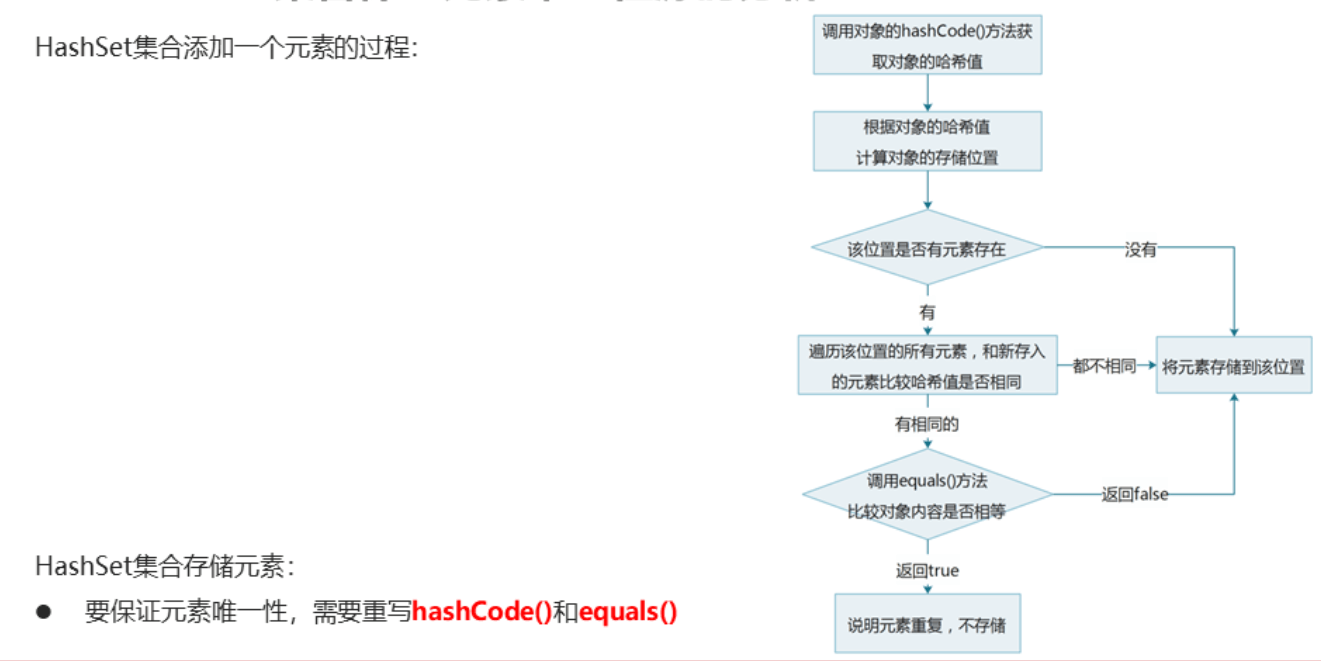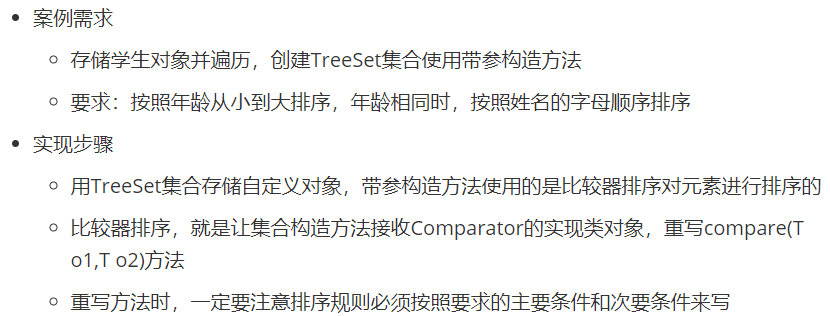Java 单列集合 Java 深入浅出掌握Collection单列集合Set
乔巴菌儿 人气:0前言
Hello!上一期我大致讲解了关于Collection单列集合以及它的子接口List集合的概述、特点和遍历等,今天我为大家讲解关于Collection集合的另一个子接口-->Set集合的相关知识点。

Set集合
Set概述
【1】Set集合类似于一个集装箱,程序可以依次将这些货物(多个对象)装运进此集装箱,而Set集合往往不能记住装运这些货物的顺序(元素的添加顺序),且不允许装运相同的货物。
【2】Set集合不允许包含相同的元素,如果试图把两个相同元素加入同一个Set集合中,则添加操作失败,add()方法返回false,且新元素不会被加入。
Set特点
- 元素存取无序
- 没有索引、只能通过迭代器或增强for循环遍历
- 不能存储重复元素
public class SetDemo_01 {
public static void main(String[] args) {
Set<String> set = new HashSet<>();
//添加元素
set.add("Hello");
set.add("World");
set.add("Java");
set.add("Hello");//Set不包含重复元素的集合,(相同的,只输出一个)
//Set没有索引、只能通过迭代器或增强for循环遍历且元素存取无序
//迭代器遍历
Iterator<String> it = set.iterator();
while(it.hasNext()) {
String s = it.next();
System.out.println(s);
}
//增强for
for (String s : set) {
System.out.println(s);
}
}
}
HashSet集合
HashSet概述
HashSet是Set接口的典型实现,大多数时候使用Set集合时就是使用这个实现类。HashSet按Hash算法来存储集合中的元素,因此具有很好的存取和查找性能。底层数据结构是哈希表。
哈希值:
哈希值简介:是JDK根据对象的地址或者字符串或者数字算出来的int类型的数值
如何获取哈希值:Object类中的public int hashCode():返回对象的哈希码值
哈希值的特点:(1)同一个对象多次调用hashCode()方法返回的哈希值是相同的;(2)默认情况下,不同对象的哈希值是不同的。而重写hashCode()方法,可以实现让不同对象的哈希值相同
HashSet特点
- 底层数据结构是哈希表
- 对集合的迭代顺序不作任何保证,也就是说不保证存储和取出的元素顺序一致
- 没有带索引的方法,所以不能使用普通for循环遍历
- 由于是Set集合,所以不包含重复元素的集合
public class HashSetDemo_01 {
public static void main(String[] args) {
//创建集合对象
HashSet<String> hs = new HashSet<>();
//添加元素
hs.add("Hello");
hs.add("World");
hs.add("Java");
hs.add("Java");//由于是Set集合,所以是不包含重复元素的集合.相同的元素,只输出一个
//没有带索引的方法,所以不能使用普通for循环遍历
//迭代器方式
Iterator<String> it = hs.iterator();
while (it.hasNext()) {
String s = it.next();
System.out.println(s);
}
System.out.println("----------------");
//增强for
for (String s : hs) {
System.out.println(s);
}
}
}
HashSet集合保证元素唯一性源码分析
HashSet集合保证元素唯一性的原理:
- 根据对象的哈希值计算存储位置( 1.如果当前位置没有元素则直接存入; 如果当前位置有元素存在,则进入第二步)
- 当前元素的元素和已经存在的元素比较哈希值(1. 如果哈希值不同,则将当前元素进行存储; 如果哈希值相同,则进入第三步)
- 通过equals()方法比较两个元素的内容(1. 如果内容不相同,则将当前元素进行存储;2.如果内容相同,则不存储当前元素)
HashSet集合保证元素唯一性的图解

LinkedHashSet集合
LinkedHashSet概述与特点
他是Set集合典型实现类HashSet的子类,继承了set集合的所有功能和特点,同时把其中的重要特点给修改,把无序变为有序。
- 哈希表和链表实现的Set接口,具有可预测的迭代次序
- 由链表保证元素有序,也就是说元素的存储和取出顺序是一致的
- 由哈希表保证元素唯一,也就是说没有重复的元素
public class LinkedHashSetDemo {
public static void main(String[] args) {
//创建LinkedHashSet集合对象
LinkedHashSet<String> lhs = new LinkedHashSet<>();
lhs.add("Hello");
lhs.add("World");
lhs.add("Java");
//由哈希表保证元素唯一,也就是说没有重复的元素
lhs.add("Java");
/*哈希表和链表实现的Set接口,具有可预测的迭代次序
由链表保证元素有序,也就是说元素的存储和取出顺序是一致的*/
//遍历集合
for (String s : lhs) {
System.out.println(s);
}
}
}
TreeSet集合
TreeSet是SortedSet接口的实现类,TreeSet可以确保集合元素处于排序状态。
TreeSet特点
- 元素有序,可以按照一定的规则进行排序,具体排序方式取决于构造方法
- 没有带索引的方法,所以不能使用普通for循环遍历
- 由于是Set集合,所以不包含重复元素的集合
TreeSet(排序方式)
TreeSet():根据其元素的自然排序进行排序。TreeSet会调用集合元素的compareTo(Objec obj)方法来比较元素之间的大小关系,然后将集合元素按升序排列,这就是自然排序。
TreeSet(Comparator comparator) :根据指定的比较器进行排序。
这里我给出视频讲解里的关于比较器排序Comparator的使用的案例:

- 学生类
public class Student {
private String name;
private int age;
public Student() {
}
public Student(String name, int age) {
this.name = name;
this.age = age;
}
public String getName() {
return name;
}
public void setName(String name) {
this.name = name;
}
public int getAge() {
return age;
}
public void setAge(int age) {
this.age = age;
}
}
- 测试类
public class TreeSetDemo {
public static void main(String[] args) {
//创建集合对象
TreeSet<Student> ts = new TreeSet<Student>(new Comparator<Student>() {
@Override
public int compare(Student s1, Student s2) {
//this.age - s.age
//s1,s2
int num = s1.getAge() - s2.getAge();
int num2 = num == 0 ? s1.getName().compareTo(s2.getName()) : num;
return num2;
}
});
//创建学生对象
Student s1 = new Student("xishi", 29);
Student s2 = new Student("wangzhaojun", 28);
Student s3 = new Student("diaochan", 30);
Student s4 = new Student("yangyuhuan", 33);
Student s5 = new Student("linqingxia",33);
Student s6 = new Student("linqingxia",33);
//把学生添加到集合
ts.add(s1);
ts.add(s2);
ts.add(s3);
ts.add(s4);
ts.add(s5);
ts.add(s6);
//遍历集合
for (Student s : ts) {
System.out.println(s.getName() + "," + s.getAge());
}
}
}
总结
Set和List对比:
Set:检索元素效率低下,删除和插入效率高,插入和删除不会引起元素位置改变。
List:和数组类似,List可以动态增长,查找元素效率高,插入删除元素效率低,因为会引起其他元素位置改变。
【1】HashSet采用哈希表的存储结构所以里面的数据是无序但是唯一的。(实现唯一的方式就是重写 Hashcode和equals方法)
【2】TreeSet支持两种排序方法:自然排序和定制排序,TreeSet默认采用自然排序。
今日的有关Set集合内容的分享就到这了,下期Map集合再会!(可以给个爱心吗,友友们)

加载全部内容